Person-Centered Care Report: Health Promotion and Legislation
VerifiedAdded on 2022/11/29
|12
|4006
|320
Report
AI Summary
This report focuses on person-centered care within a health and social care context, specifically examining the role of a care assistant at a Place of Safety. It begins by comparing person-centered care with other models, emphasizing the importance of promoting equality and diversity through tailored care plans and staff training. The report then delves into the required personal attributes for care assistants, such as empathy, communication, and teamwork, along with an explanation of the concept of empathy. Ethical considerations are addressed, including defining ethics with reference to medical principles like autonomy, justice, beneficence, and non-maleficence, and identifying ethical issues that may arise in the care of children. The report also explores relevant legislation, including the Health and Social Care Act 2012 and the Care Act 2014, and analyzes the roles of agencies like Public Health England and the UK Health Security Agency in providing guidance for safe and effective care. Finally, the report outlines the development and analysis of a health promotion campaign designed to promote physical activity, including health promotion materials for a target audience. The report concludes with a summary of the findings and a list of references.
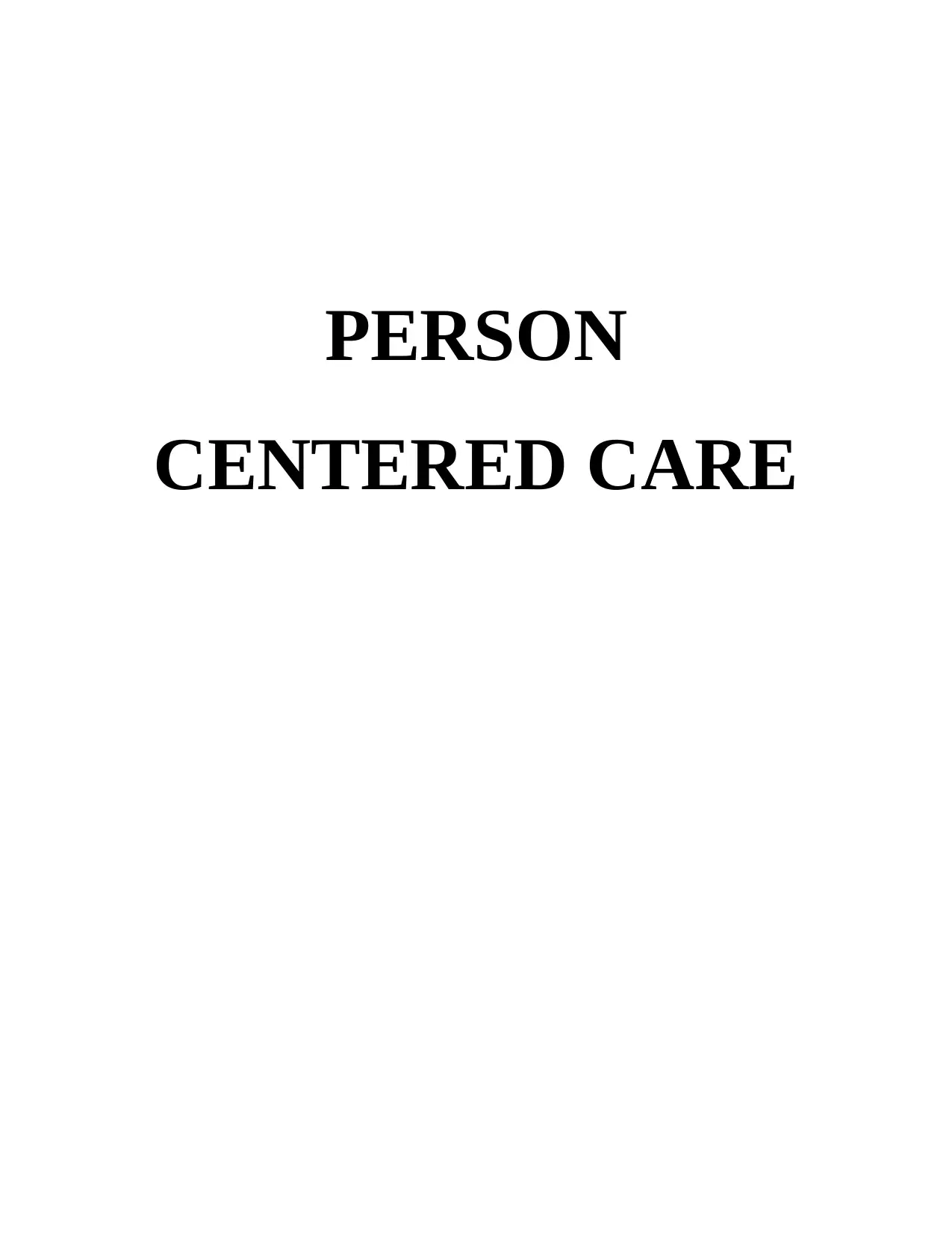
PERSON
CENTERED CARE
CENTERED CARE
Paraphrase This Document
Need a fresh take? Get an instant paraphrase of this document with our AI Paraphraser
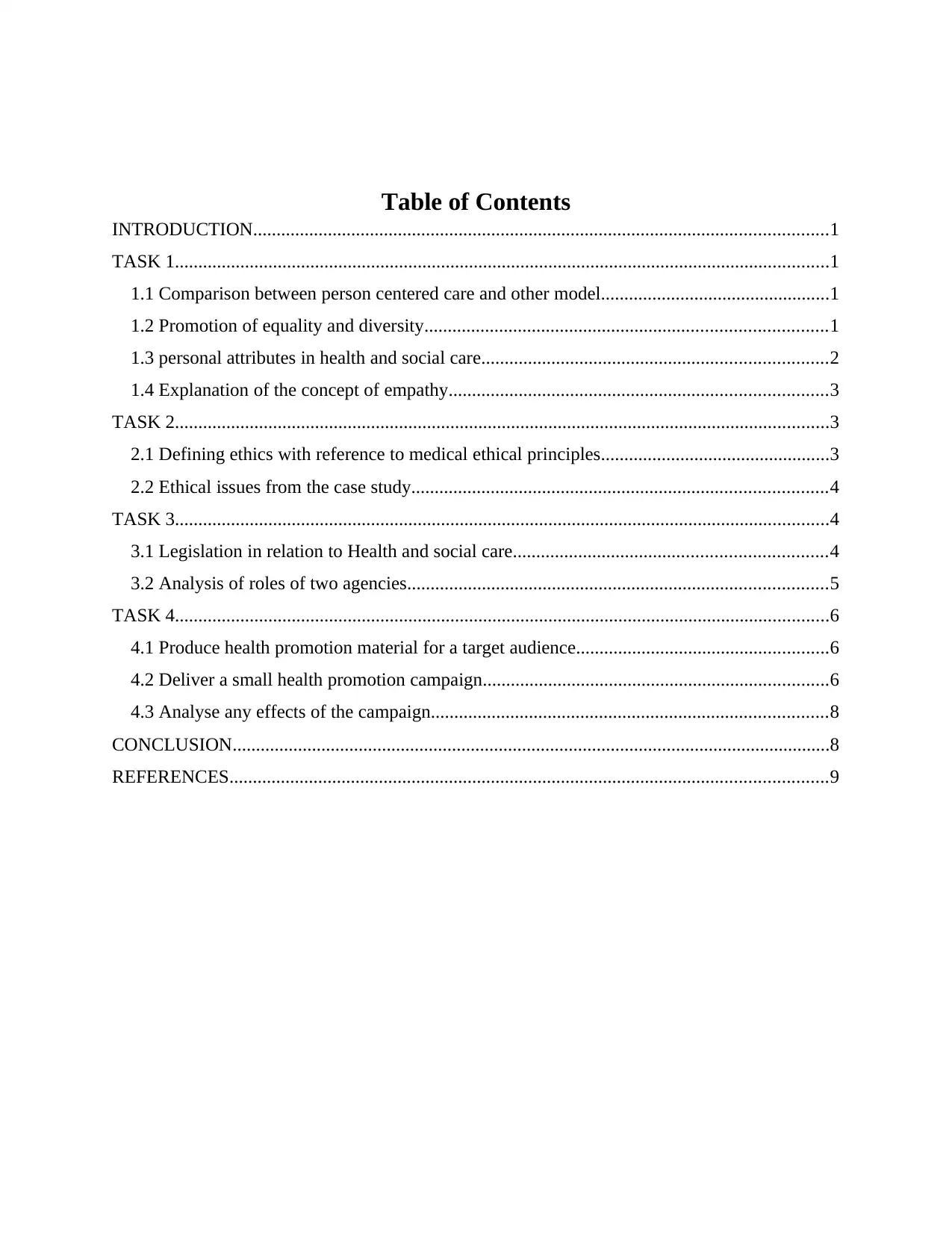
Table of Contents
INTRODUCTION...........................................................................................................................1
TASK 1............................................................................................................................................1
1.1 Comparison between person centered care and other model.................................................1
1.2 Promotion of equality and diversity......................................................................................1
1.3 personal attributes in health and social care..........................................................................2
1.4 Explanation of the concept of empathy.................................................................................3
TASK 2............................................................................................................................................3
2.1 Defining ethics with reference to medical ethical principles.................................................3
2.2 Ethical issues from the case study.........................................................................................4
TASK 3............................................................................................................................................4
3.1 Legislation in relation to Health and social care...................................................................4
3.2 Analysis of roles of two agencies..........................................................................................5
TASK 4............................................................................................................................................6
4.1 Produce health promotion material for a target audience......................................................6
4.2 Deliver a small health promotion campaign..........................................................................6
4.3 Analyse any effects of the campaign.....................................................................................8
CONCLUSION................................................................................................................................8
REFERENCES................................................................................................................................9
INTRODUCTION...........................................................................................................................1
TASK 1............................................................................................................................................1
1.1 Comparison between person centered care and other model.................................................1
1.2 Promotion of equality and diversity......................................................................................1
1.3 personal attributes in health and social care..........................................................................2
1.4 Explanation of the concept of empathy.................................................................................3
TASK 2............................................................................................................................................3
2.1 Defining ethics with reference to medical ethical principles.................................................3
2.2 Ethical issues from the case study.........................................................................................4
TASK 3............................................................................................................................................4
3.1 Legislation in relation to Health and social care...................................................................4
3.2 Analysis of roles of two agencies..........................................................................................5
TASK 4............................................................................................................................................6
4.1 Produce health promotion material for a target audience......................................................6
4.2 Deliver a small health promotion campaign..........................................................................6
4.3 Analyse any effects of the campaign.....................................................................................8
CONCLUSION................................................................................................................................8
REFERENCES................................................................................................................................9
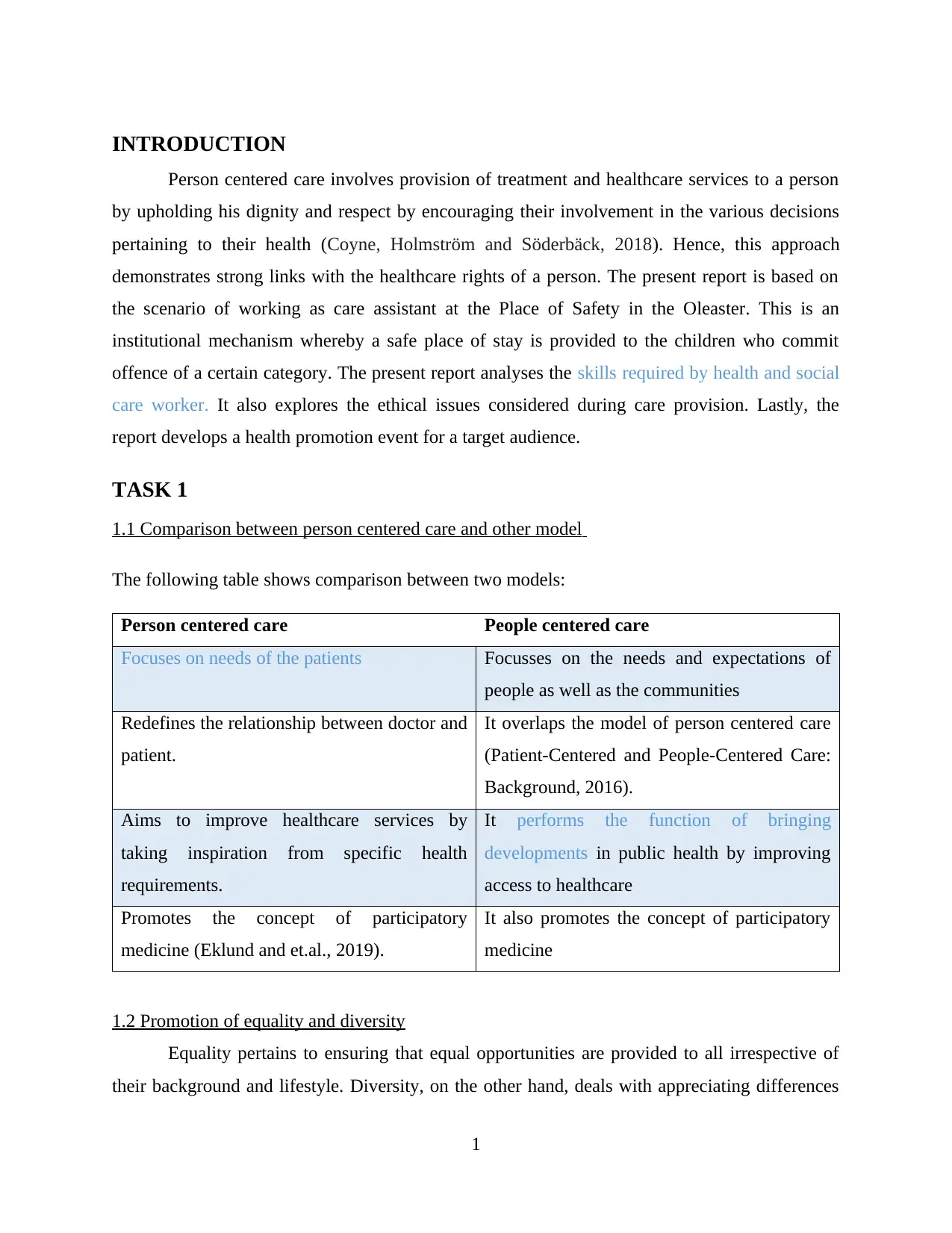
INTRODUCTION
Person centered care involves provision of treatment and healthcare services to a person
by upholding his dignity and respect by encouraging their involvement in the various decisions
pertaining to their health (Coyne, Holmström and Söderbäck, 2018). Hence, this approach
demonstrates strong links with the healthcare rights of a person. The present report is based on
the scenario of working as care assistant at the Place of Safety in the Oleaster. This is an
institutional mechanism whereby a safe place of stay is provided to the children who commit
offence of a certain category. The present report analyses the skills required by health and social
care worker. It also explores the ethical issues considered during care provision. Lastly, the
report develops a health promotion event for a target audience.
TASK 1
1.1 Comparison between person centered care and other model
The following table shows comparison between two models:
Person centered care People centered care
Focuses on needs of the patients Focusses on the needs and expectations of
people as well as the communities
Redefines the relationship between doctor and
patient.
It overlaps the model of person centered care
(Patient-Centered and People-Centered Care:
Background, 2016).
Aims to improve healthcare services by
taking inspiration from specific health
requirements.
It performs the function of bringing
developments in public health by improving
access to healthcare
Promotes the concept of participatory
medicine (Eklund and et.al., 2019).
It also promotes the concept of participatory
medicine
1.2 Promotion of equality and diversity
Equality pertains to ensuring that equal opportunities are provided to all irrespective of
their background and lifestyle. Diversity, on the other hand, deals with appreciating differences
1
Person centered care involves provision of treatment and healthcare services to a person
by upholding his dignity and respect by encouraging their involvement in the various decisions
pertaining to their health (Coyne, Holmström and Söderbäck, 2018). Hence, this approach
demonstrates strong links with the healthcare rights of a person. The present report is based on
the scenario of working as care assistant at the Place of Safety in the Oleaster. This is an
institutional mechanism whereby a safe place of stay is provided to the children who commit
offence of a certain category. The present report analyses the skills required by health and social
care worker. It also explores the ethical issues considered during care provision. Lastly, the
report develops a health promotion event for a target audience.
TASK 1
1.1 Comparison between person centered care and other model
The following table shows comparison between two models:
Person centered care People centered care
Focuses on needs of the patients Focusses on the needs and expectations of
people as well as the communities
Redefines the relationship between doctor and
patient.
It overlaps the model of person centered care
(Patient-Centered and People-Centered Care:
Background, 2016).
Aims to improve healthcare services by
taking inspiration from specific health
requirements.
It performs the function of bringing
developments in public health by improving
access to healthcare
Promotes the concept of participatory
medicine (Eklund and et.al., 2019).
It also promotes the concept of participatory
medicine
1.2 Promotion of equality and diversity
Equality pertains to ensuring that equal opportunities are provided to all irrespective of
their background and lifestyle. Diversity, on the other hand, deals with appreciating differences
1
⊘ This is a preview!⊘
Do you want full access?
Subscribe today to unlock all pages.

Trusted by 1+ million students worldwide
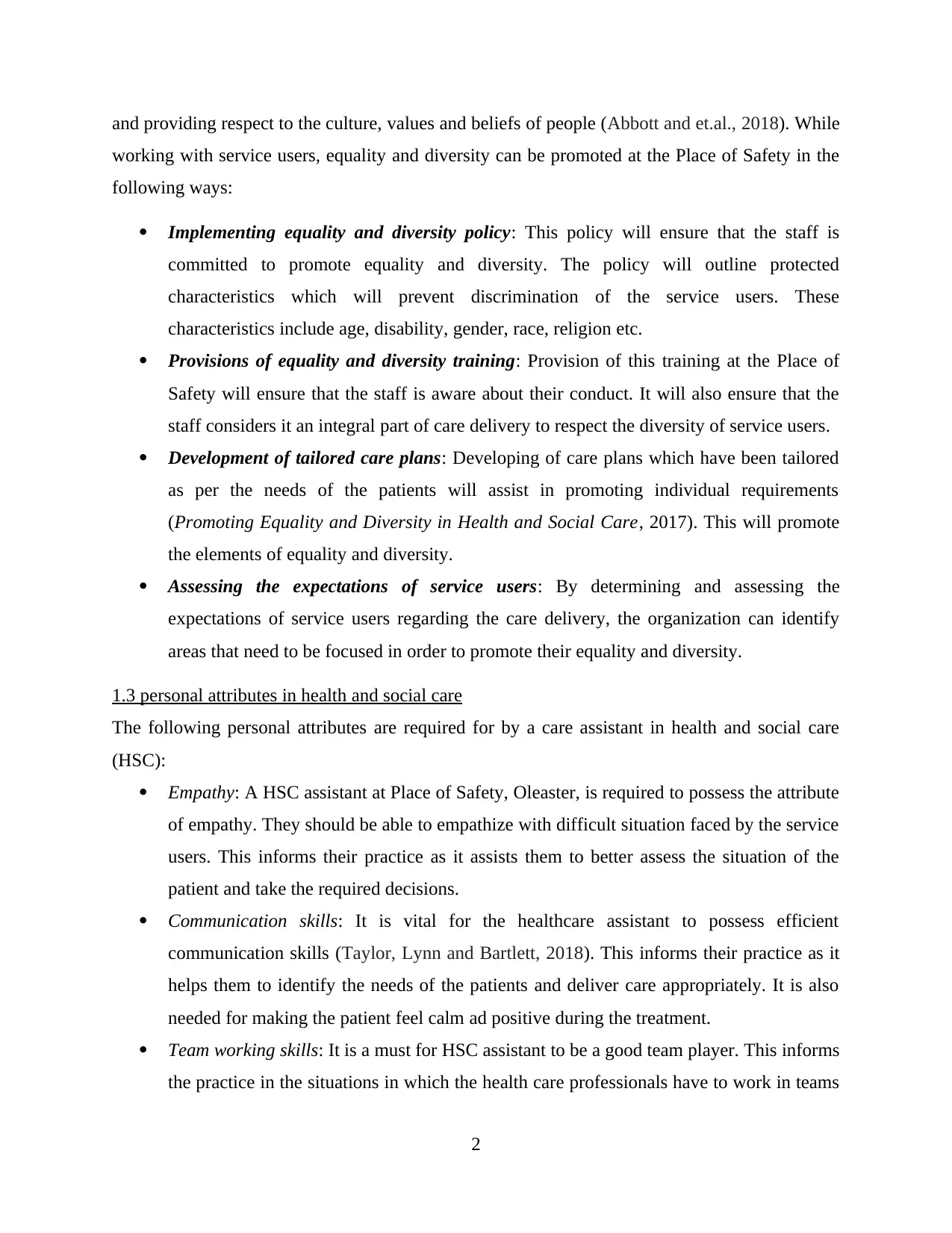
and providing respect to the culture, values and beliefs of people (Abbott and et.al., 2018). While
working with service users, equality and diversity can be promoted at the Place of Safety in the
following ways:
Implementing equality and diversity policy: This policy will ensure that the staff is
committed to promote equality and diversity. The policy will outline protected
characteristics which will prevent discrimination of the service users. These
characteristics include age, disability, gender, race, religion etc.
Provisions of equality and diversity training: Provision of this training at the Place of
Safety will ensure that the staff is aware about their conduct. It will also ensure that the
staff considers it an integral part of care delivery to respect the diversity of service users.
Development of tailored care plans: Developing of care plans which have been tailored
as per the needs of the patients will assist in promoting individual requirements
(Promoting Equality and Diversity in Health and Social Care, 2017). This will promote
the elements of equality and diversity.
Assessing the expectations of service users: By determining and assessing the
expectations of service users regarding the care delivery, the organization can identify
areas that need to be focused in order to promote their equality and diversity.
1.3 personal attributes in health and social care
The following personal attributes are required for by a care assistant in health and social care
(HSC):
Empathy: A HSC assistant at Place of Safety, Oleaster, is required to possess the attribute
of empathy. They should be able to empathize with difficult situation faced by the service
users. This informs their practice as it assists them to better assess the situation of the
patient and take the required decisions.
Communication skills: It is vital for the healthcare assistant to possess efficient
communication skills (Taylor, Lynn and Bartlett, 2018). This informs their practice as it
helps them to identify the needs of the patients and deliver care appropriately. It is also
needed for making the patient feel calm ad positive during the treatment.
Team working skills: It is a must for HSC assistant to be a good team player. This informs
the practice in the situations in which the health care professionals have to work in teams
2
working with service users, equality and diversity can be promoted at the Place of Safety in the
following ways:
Implementing equality and diversity policy: This policy will ensure that the staff is
committed to promote equality and diversity. The policy will outline protected
characteristics which will prevent discrimination of the service users. These
characteristics include age, disability, gender, race, religion etc.
Provisions of equality and diversity training: Provision of this training at the Place of
Safety will ensure that the staff is aware about their conduct. It will also ensure that the
staff considers it an integral part of care delivery to respect the diversity of service users.
Development of tailored care plans: Developing of care plans which have been tailored
as per the needs of the patients will assist in promoting individual requirements
(Promoting Equality and Diversity in Health and Social Care, 2017). This will promote
the elements of equality and diversity.
Assessing the expectations of service users: By determining and assessing the
expectations of service users regarding the care delivery, the organization can identify
areas that need to be focused in order to promote their equality and diversity.
1.3 personal attributes in health and social care
The following personal attributes are required for by a care assistant in health and social care
(HSC):
Empathy: A HSC assistant at Place of Safety, Oleaster, is required to possess the attribute
of empathy. They should be able to empathize with difficult situation faced by the service
users. This informs their practice as it assists them to better assess the situation of the
patient and take the required decisions.
Communication skills: It is vital for the healthcare assistant to possess efficient
communication skills (Taylor, Lynn and Bartlett, 2018). This informs their practice as it
helps them to identify the needs of the patients and deliver care appropriately. It is also
needed for making the patient feel calm ad positive during the treatment.
Team working skills: It is a must for HSC assistant to be a good team player. This informs
the practice in the situations in which the health care professionals have to work in teams
2
Paraphrase This Document
Need a fresh take? Get an instant paraphrase of this document with our AI Paraphraser
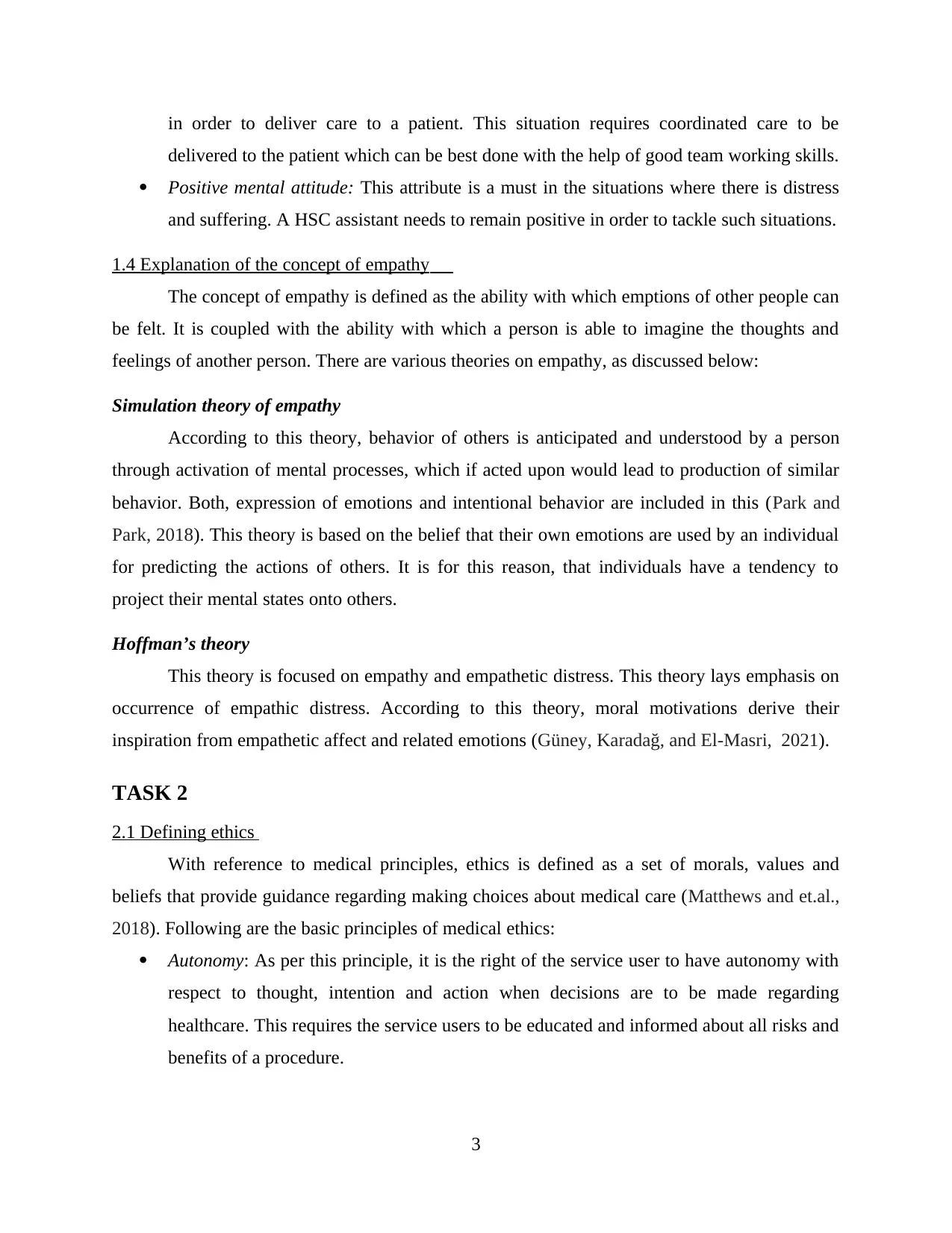
in order to deliver care to a patient. This situation requires coordinated care to be
delivered to the patient which can be best done with the help of good team working skills.
Positive mental attitude: This attribute is a must in the situations where there is distress
and suffering. A HSC assistant needs to remain positive in order to tackle such situations.
1.4 Explanation of the concept of empathy
The concept of empathy is defined as the ability with which emptions of other people can
be felt. It is coupled with the ability with which a person is able to imagine the thoughts and
feelings of another person. There are various theories on empathy, as discussed below:
Simulation theory of empathy
According to this theory, behavior of others is anticipated and understood by a person
through activation of mental processes, which if acted upon would lead to production of similar
behavior. Both, expression of emotions and intentional behavior are included in this (Park and
Park, 2018). This theory is based on the belief that their own emotions are used by an individual
for predicting the actions of others. It is for this reason, that individuals have a tendency to
project their mental states onto others.
Hoffman’s theory
This theory is focused on empathy and empathetic distress. This theory lays emphasis on
occurrence of empathic distress. According to this theory, moral motivations derive their
inspiration from empathetic affect and related emotions (Güney, Karadağ, and El-Masri, 2021).
TASK 2
2.1 Defining ethics
With reference to medical principles, ethics is defined as a set of morals, values and
beliefs that provide guidance regarding making choices about medical care (Matthews and et.al.,
2018). Following are the basic principles of medical ethics:
Autonomy: As per this principle, it is the right of the service user to have autonomy with
respect to thought, intention and action when decisions are to be made regarding
healthcare. This requires the service users to be educated and informed about all risks and
benefits of a procedure.
3
delivered to the patient which can be best done with the help of good team working skills.
Positive mental attitude: This attribute is a must in the situations where there is distress
and suffering. A HSC assistant needs to remain positive in order to tackle such situations.
1.4 Explanation of the concept of empathy
The concept of empathy is defined as the ability with which emptions of other people can
be felt. It is coupled with the ability with which a person is able to imagine the thoughts and
feelings of another person. There are various theories on empathy, as discussed below:
Simulation theory of empathy
According to this theory, behavior of others is anticipated and understood by a person
through activation of mental processes, which if acted upon would lead to production of similar
behavior. Both, expression of emotions and intentional behavior are included in this (Park and
Park, 2018). This theory is based on the belief that their own emotions are used by an individual
for predicting the actions of others. It is for this reason, that individuals have a tendency to
project their mental states onto others.
Hoffman’s theory
This theory is focused on empathy and empathetic distress. This theory lays emphasis on
occurrence of empathic distress. According to this theory, moral motivations derive their
inspiration from empathetic affect and related emotions (Güney, Karadağ, and El-Masri, 2021).
TASK 2
2.1 Defining ethics
With reference to medical principles, ethics is defined as a set of morals, values and
beliefs that provide guidance regarding making choices about medical care (Matthews and et.al.,
2018). Following are the basic principles of medical ethics:
Autonomy: As per this principle, it is the right of the service user to have autonomy with
respect to thought, intention and action when decisions are to be made regarding
healthcare. This requires the service users to be educated and informed about all risks and
benefits of a procedure.
3
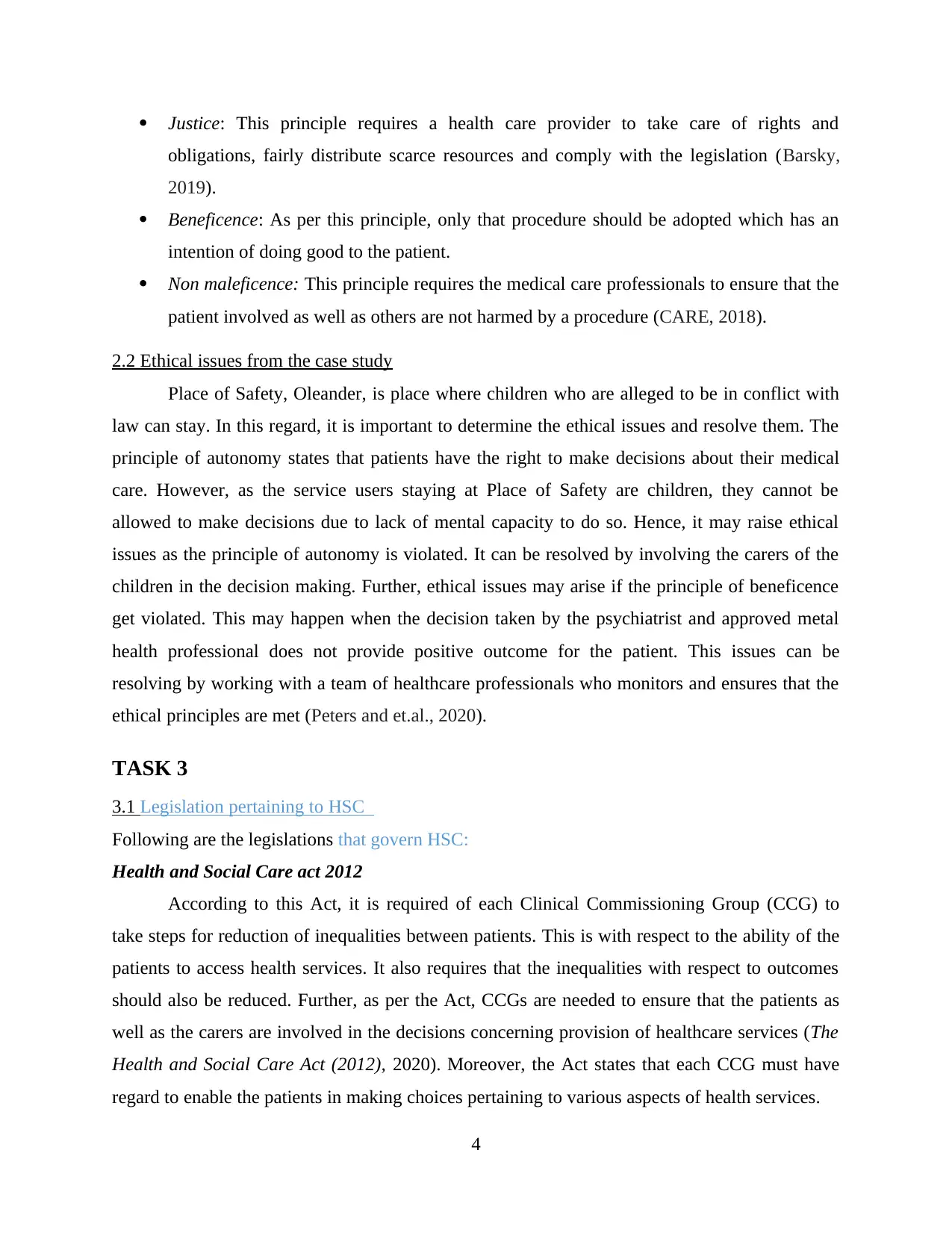
Justice: This principle requires a health care provider to take care of rights and
obligations, fairly distribute scarce resources and comply with the legislation (Barsky,
2019).
Beneficence: As per this principle, only that procedure should be adopted which has an
intention of doing good to the patient.
Non maleficence: This principle requires the medical care professionals to ensure that the
patient involved as well as others are not harmed by a procedure (CARE, 2018).
2.2 Ethical issues from the case study
Place of Safety, Oleander, is place where children who are alleged to be in conflict with
law can stay. In this regard, it is important to determine the ethical issues and resolve them. The
principle of autonomy states that patients have the right to make decisions about their medical
care. However, as the service users staying at Place of Safety are children, they cannot be
allowed to make decisions due to lack of mental capacity to do so. Hence, it may raise ethical
issues as the principle of autonomy is violated. It can be resolved by involving the carers of the
children in the decision making. Further, ethical issues may arise if the principle of beneficence
get violated. This may happen when the decision taken by the psychiatrist and approved metal
health professional does not provide positive outcome for the patient. This issues can be
resolving by working with a team of healthcare professionals who monitors and ensures that the
ethical principles are met (Peters and et.al., 2020).
TASK 3
3.1 Legislation pertaining to HSC
Following are the legislations that govern HSC:
Health and Social Care act 2012
According to this Act, it is required of each Clinical Commissioning Group (CCG) to
take steps for reduction of inequalities between patients. This is with respect to the ability of the
patients to access health services. It also requires that the inequalities with respect to outcomes
should also be reduced. Further, as per the Act, CCGs are needed to ensure that the patients as
well as the carers are involved in the decisions concerning provision of healthcare services (The
Health and Social Care Act (2012), 2020). Moreover, the Act states that each CCG must have
regard to enable the patients in making choices pertaining to various aspects of health services.
4
obligations, fairly distribute scarce resources and comply with the legislation (Barsky,
2019).
Beneficence: As per this principle, only that procedure should be adopted which has an
intention of doing good to the patient.
Non maleficence: This principle requires the medical care professionals to ensure that the
patient involved as well as others are not harmed by a procedure (CARE, 2018).
2.2 Ethical issues from the case study
Place of Safety, Oleander, is place where children who are alleged to be in conflict with
law can stay. In this regard, it is important to determine the ethical issues and resolve them. The
principle of autonomy states that patients have the right to make decisions about their medical
care. However, as the service users staying at Place of Safety are children, they cannot be
allowed to make decisions due to lack of mental capacity to do so. Hence, it may raise ethical
issues as the principle of autonomy is violated. It can be resolved by involving the carers of the
children in the decision making. Further, ethical issues may arise if the principle of beneficence
get violated. This may happen when the decision taken by the psychiatrist and approved metal
health professional does not provide positive outcome for the patient. This issues can be
resolving by working with a team of healthcare professionals who monitors and ensures that the
ethical principles are met (Peters and et.al., 2020).
TASK 3
3.1 Legislation pertaining to HSC
Following are the legislations that govern HSC:
Health and Social Care act 2012
According to this Act, it is required of each Clinical Commissioning Group (CCG) to
take steps for reduction of inequalities between patients. This is with respect to the ability of the
patients to access health services. It also requires that the inequalities with respect to outcomes
should also be reduced. Further, as per the Act, CCGs are needed to ensure that the patients as
well as the carers are involved in the decisions concerning provision of healthcare services (The
Health and Social Care Act (2012), 2020). Moreover, the Act states that each CCG must have
regard to enable the patients in making choices pertaining to various aspects of health services.
4
⊘ This is a preview!⊘
Do you want full access?
Subscribe today to unlock all pages.

Trusted by 1+ million students worldwide
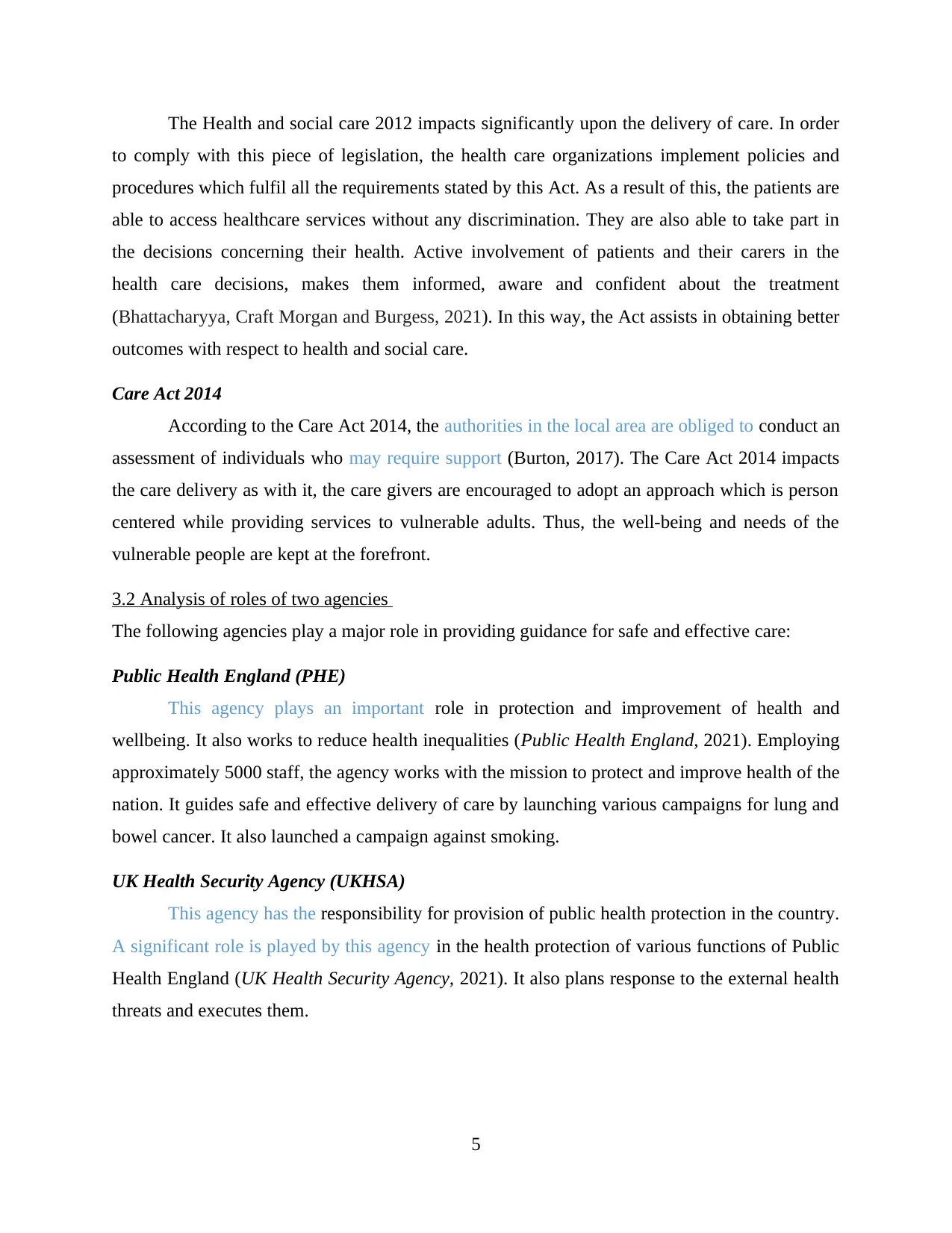
The Health and social care 2012 impacts significantly upon the delivery of care. In order
to comply with this piece of legislation, the health care organizations implement policies and
procedures which fulfil all the requirements stated by this Act. As a result of this, the patients are
able to access healthcare services without any discrimination. They are also able to take part in
the decisions concerning their health. Active involvement of patients and their carers in the
health care decisions, makes them informed, aware and confident about the treatment
(Bhattacharyya, Craft Morgan and Burgess, 2021). In this way, the Act assists in obtaining better
outcomes with respect to health and social care.
Care Act 2014
According to the Care Act 2014, the authorities in the local area are obliged to conduct an
assessment of individuals who may require support (Burton, 2017). The Care Act 2014 impacts
the care delivery as with it, the care givers are encouraged to adopt an approach which is person
centered while providing services to vulnerable adults. Thus, the well-being and needs of the
vulnerable people are kept at the forefront.
3.2 Analysis of roles of two agencies
The following agencies play a major role in providing guidance for safe and effective care:
Public Health England (PHE)
This agency plays an important role in protection and improvement of health and
wellbeing. It also works to reduce health inequalities (Public Health England, 2021). Employing
approximately 5000 staff, the agency works with the mission to protect and improve health of the
nation. It guides safe and effective delivery of care by launching various campaigns for lung and
bowel cancer. It also launched a campaign against smoking.
UK Health Security Agency (UKHSA)
This agency has the responsibility for provision of public health protection in the country.
A significant role is played by this agency in the health protection of various functions of Public
Health England (UK Health Security Agency, 2021). It also plans response to the external health
threats and executes them.
5
to comply with this piece of legislation, the health care organizations implement policies and
procedures which fulfil all the requirements stated by this Act. As a result of this, the patients are
able to access healthcare services without any discrimination. They are also able to take part in
the decisions concerning their health. Active involvement of patients and their carers in the
health care decisions, makes them informed, aware and confident about the treatment
(Bhattacharyya, Craft Morgan and Burgess, 2021). In this way, the Act assists in obtaining better
outcomes with respect to health and social care.
Care Act 2014
According to the Care Act 2014, the authorities in the local area are obliged to conduct an
assessment of individuals who may require support (Burton, 2017). The Care Act 2014 impacts
the care delivery as with it, the care givers are encouraged to adopt an approach which is person
centered while providing services to vulnerable adults. Thus, the well-being and needs of the
vulnerable people are kept at the forefront.
3.2 Analysis of roles of two agencies
The following agencies play a major role in providing guidance for safe and effective care:
Public Health England (PHE)
This agency plays an important role in protection and improvement of health and
wellbeing. It also works to reduce health inequalities (Public Health England, 2021). Employing
approximately 5000 staff, the agency works with the mission to protect and improve health of the
nation. It guides safe and effective delivery of care by launching various campaigns for lung and
bowel cancer. It also launched a campaign against smoking.
UK Health Security Agency (UKHSA)
This agency has the responsibility for provision of public health protection in the country.
A significant role is played by this agency in the health protection of various functions of Public
Health England (UK Health Security Agency, 2021). It also plans response to the external health
threats and executes them.
5
Paraphrase This Document
Need a fresh take? Get an instant paraphrase of this document with our AI Paraphraser
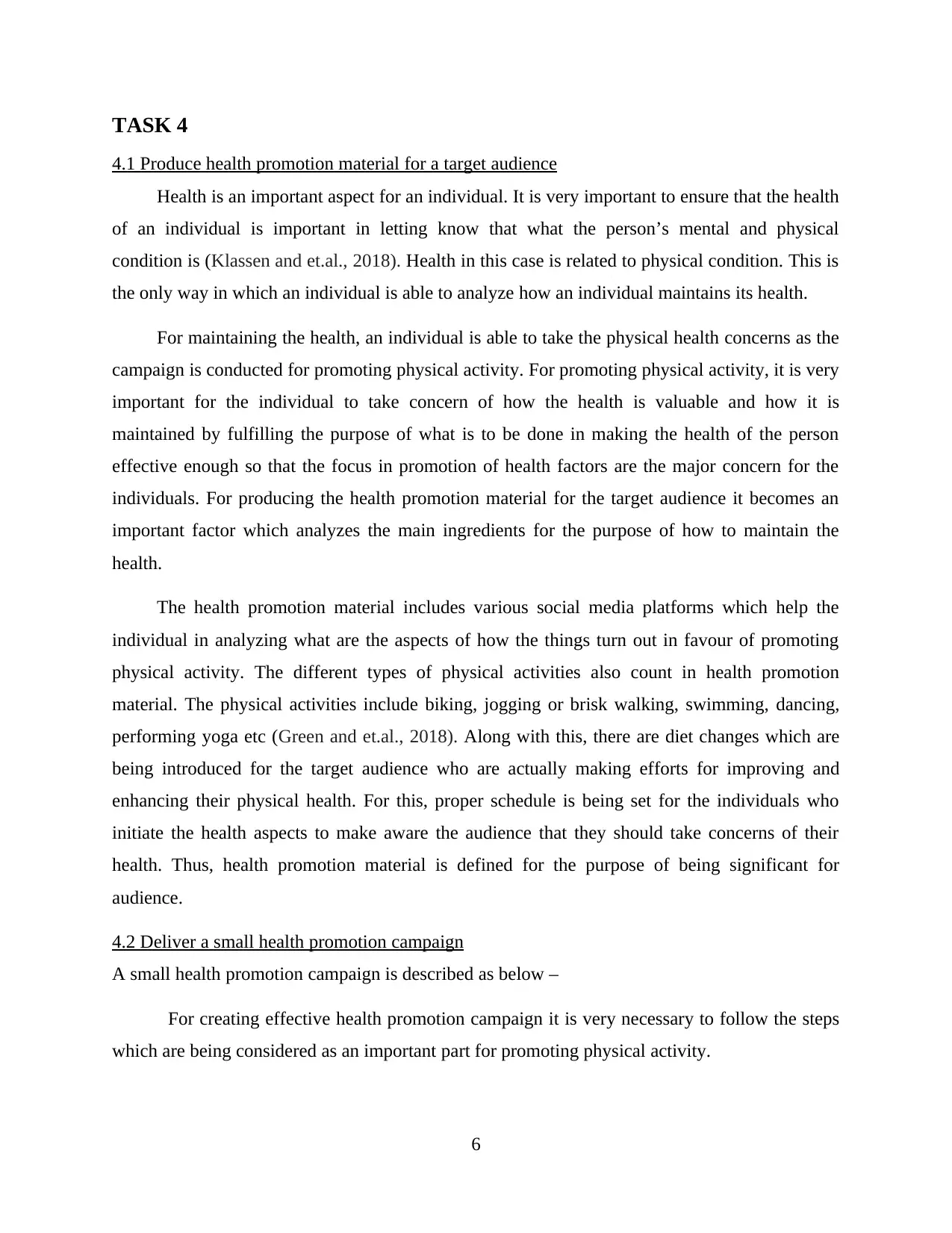
TASK 4
4.1 Produce health promotion material for a target audience
Health is an important aspect for an individual. It is very important to ensure that the health
of an individual is important in letting know that what the person’s mental and physical
condition is (Klassen and et.al., 2018). Health in this case is related to physical condition. This is
the only way in which an individual is able to analyze how an individual maintains its health.
For maintaining the health, an individual is able to take the physical health concerns as the
campaign is conducted for promoting physical activity. For promoting physical activity, it is very
important for the individual to take concern of how the health is valuable and how it is
maintained by fulfilling the purpose of what is to be done in making the health of the person
effective enough so that the focus in promotion of health factors are the major concern for the
individuals. For producing the health promotion material for the target audience it becomes an
important factor which analyzes the main ingredients for the purpose of how to maintain the
health.
The health promotion material includes various social media platforms which help the
individual in analyzing what are the aspects of how the things turn out in favour of promoting
physical activity. The different types of physical activities also count in health promotion
material. The physical activities include biking, jogging or brisk walking, swimming, dancing,
performing yoga etc (Green and et.al., 2018). Along with this, there are diet changes which are
being introduced for the target audience who are actually making efforts for improving and
enhancing their physical health. For this, proper schedule is being set for the individuals who
initiate the health aspects to make aware the audience that they should take concerns of their
health. Thus, health promotion material is defined for the purpose of being significant for
audience.
4.2 Deliver a small health promotion campaign
A small health promotion campaign is described as below –
For creating effective health promotion campaign it is very necessary to follow the steps
which are being considered as an important part for promoting physical activity.
6
4.1 Produce health promotion material for a target audience
Health is an important aspect for an individual. It is very important to ensure that the health
of an individual is important in letting know that what the person’s mental and physical
condition is (Klassen and et.al., 2018). Health in this case is related to physical condition. This is
the only way in which an individual is able to analyze how an individual maintains its health.
For maintaining the health, an individual is able to take the physical health concerns as the
campaign is conducted for promoting physical activity. For promoting physical activity, it is very
important for the individual to take concern of how the health is valuable and how it is
maintained by fulfilling the purpose of what is to be done in making the health of the person
effective enough so that the focus in promotion of health factors are the major concern for the
individuals. For producing the health promotion material for the target audience it becomes an
important factor which analyzes the main ingredients for the purpose of how to maintain the
health.
The health promotion material includes various social media platforms which help the
individual in analyzing what are the aspects of how the things turn out in favour of promoting
physical activity. The different types of physical activities also count in health promotion
material. The physical activities include biking, jogging or brisk walking, swimming, dancing,
performing yoga etc (Green and et.al., 2018). Along with this, there are diet changes which are
being introduced for the target audience who are actually making efforts for improving and
enhancing their physical health. For this, proper schedule is being set for the individuals who
initiate the health aspects to make aware the audience that they should take concerns of their
health. Thus, health promotion material is defined for the purpose of being significant for
audience.
4.2 Deliver a small health promotion campaign
A small health promotion campaign is described as below –
For creating effective health promotion campaign it is very necessary to follow the steps
which are being considered as an important part for promoting physical activity.
6
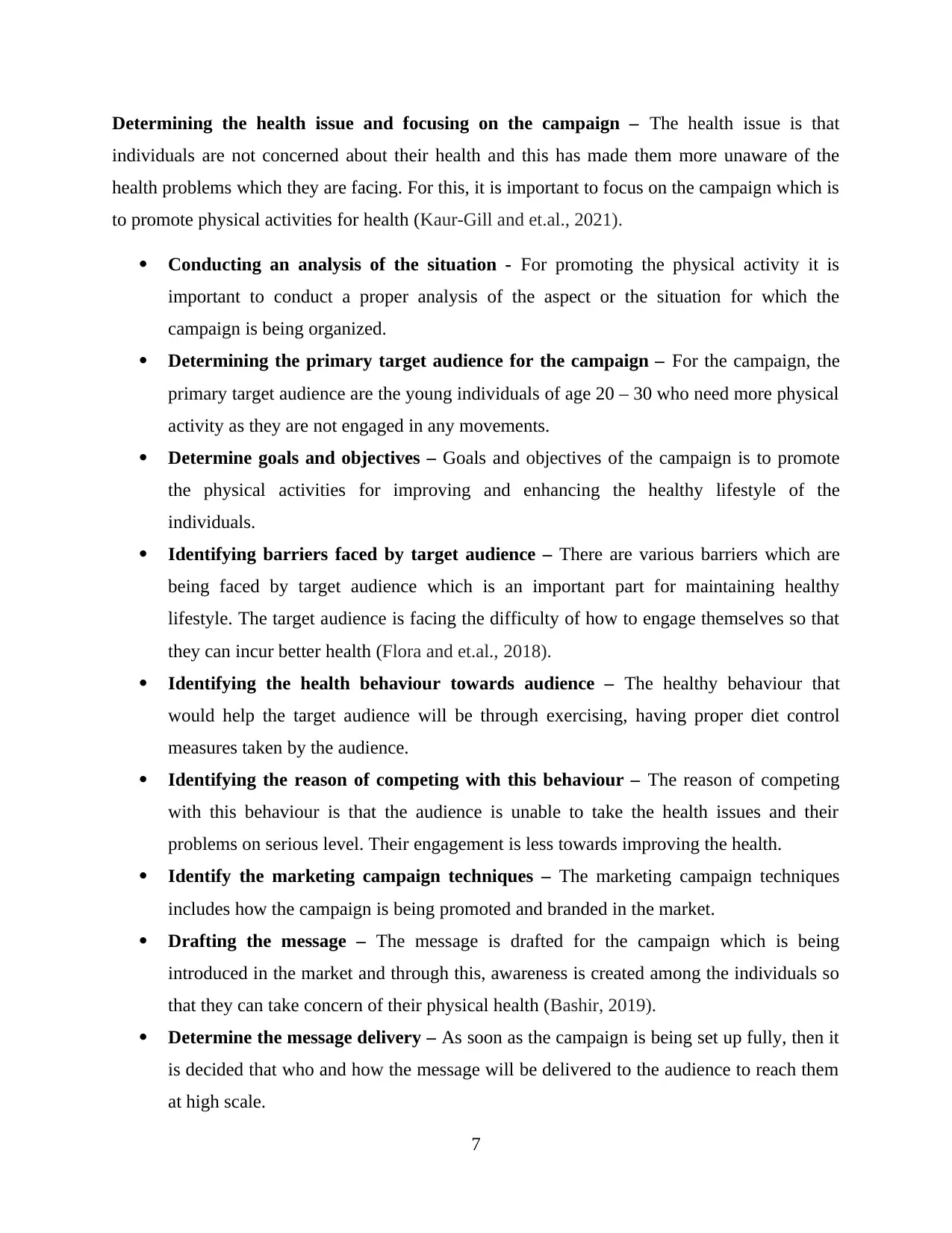
Determining the health issue and focusing on the campaign – The health issue is that
individuals are not concerned about their health and this has made them more unaware of the
health problems which they are facing. For this, it is important to focus on the campaign which is
to promote physical activities for health (Kaur‐Gill and et.al., 2021).
Conducting an analysis of the situation - For promoting the physical activity it is
important to conduct a proper analysis of the aspect or the situation for which the
campaign is being organized.
Determining the primary target audience for the campaign – For the campaign, the
primary target audience are the young individuals of age 20 – 30 who need more physical
activity as they are not engaged in any movements.
Determine goals and objectives – Goals and objectives of the campaign is to promote
the physical activities for improving and enhancing the healthy lifestyle of the
individuals.
Identifying barriers faced by target audience – There are various barriers which are
being faced by target audience which is an important part for maintaining healthy
lifestyle. The target audience is facing the difficulty of how to engage themselves so that
they can incur better health (Flora and et.al., 2018).
Identifying the health behaviour towards audience – The healthy behaviour that
would help the target audience will be through exercising, having proper diet control
measures taken by the audience.
Identifying the reason of competing with this behaviour – The reason of competing
with this behaviour is that the audience is unable to take the health issues and their
problems on serious level. Their engagement is less towards improving the health.
Identify the marketing campaign techniques – The marketing campaign techniques
includes how the campaign is being promoted and branded in the market.
Drafting the message – The message is drafted for the campaign which is being
introduced in the market and through this, awareness is created among the individuals so
that they can take concern of their physical health (Bashir, 2019).
Determine the message delivery – As soon as the campaign is being set up fully, then it
is decided that who and how the message will be delivered to the audience to reach them
at high scale.
7
individuals are not concerned about their health and this has made them more unaware of the
health problems which they are facing. For this, it is important to focus on the campaign which is
to promote physical activities for health (Kaur‐Gill and et.al., 2021).
Conducting an analysis of the situation - For promoting the physical activity it is
important to conduct a proper analysis of the aspect or the situation for which the
campaign is being organized.
Determining the primary target audience for the campaign – For the campaign, the
primary target audience are the young individuals of age 20 – 30 who need more physical
activity as they are not engaged in any movements.
Determine goals and objectives – Goals and objectives of the campaign is to promote
the physical activities for improving and enhancing the healthy lifestyle of the
individuals.
Identifying barriers faced by target audience – There are various barriers which are
being faced by target audience which is an important part for maintaining healthy
lifestyle. The target audience is facing the difficulty of how to engage themselves so that
they can incur better health (Flora and et.al., 2018).
Identifying the health behaviour towards audience – The healthy behaviour that
would help the target audience will be through exercising, having proper diet control
measures taken by the audience.
Identifying the reason of competing with this behaviour – The reason of competing
with this behaviour is that the audience is unable to take the health issues and their
problems on serious level. Their engagement is less towards improving the health.
Identify the marketing campaign techniques – The marketing campaign techniques
includes how the campaign is being promoted and branded in the market.
Drafting the message – The message is drafted for the campaign which is being
introduced in the market and through this, awareness is created among the individuals so
that they can take concern of their physical health (Bashir, 2019).
Determine the message delivery – As soon as the campaign is being set up fully, then it
is decided that who and how the message will be delivered to the audience to reach them
at high scale.
7
⊘ This is a preview!⊘
Do you want full access?
Subscribe today to unlock all pages.

Trusted by 1+ million students worldwide
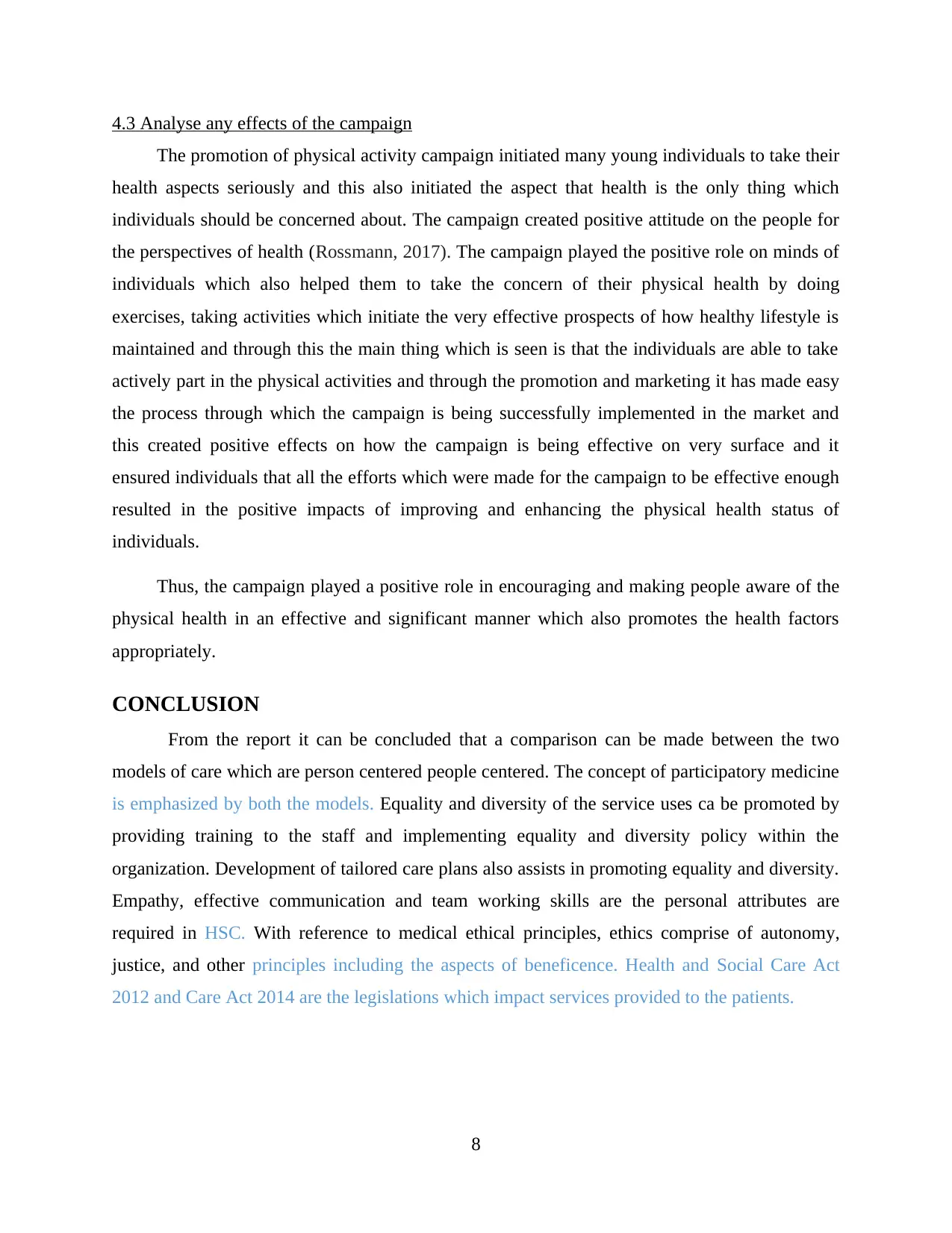
4.3 Analyse any effects of the campaign
The promotion of physical activity campaign initiated many young individuals to take their
health aspects seriously and this also initiated the aspect that health is the only thing which
individuals should be concerned about. The campaign created positive attitude on the people for
the perspectives of health (Rossmann, 2017). The campaign played the positive role on minds of
individuals which also helped them to take the concern of their physical health by doing
exercises, taking activities which initiate the very effective prospects of how healthy lifestyle is
maintained and through this the main thing which is seen is that the individuals are able to take
actively part in the physical activities and through the promotion and marketing it has made easy
the process through which the campaign is being successfully implemented in the market and
this created positive effects on how the campaign is being effective on very surface and it
ensured individuals that all the efforts which were made for the campaign to be effective enough
resulted in the positive impacts of improving and enhancing the physical health status of
individuals.
Thus, the campaign played a positive role in encouraging and making people aware of the
physical health in an effective and significant manner which also promotes the health factors
appropriately.
CONCLUSION
From the report it can be concluded that a comparison can be made between the two
models of care which are person centered people centered. The concept of participatory medicine
is emphasized by both the models. Equality and diversity of the service uses ca be promoted by
providing training to the staff and implementing equality and diversity policy within the
organization. Development of tailored care plans also assists in promoting equality and diversity.
Empathy, effective communication and team working skills are the personal attributes are
required in HSC. With reference to medical ethical principles, ethics comprise of autonomy,
justice, and other principles including the aspects of beneficence. Health and Social Care Act
2012 and Care Act 2014 are the legislations which impact services provided to the patients.
8
The promotion of physical activity campaign initiated many young individuals to take their
health aspects seriously and this also initiated the aspect that health is the only thing which
individuals should be concerned about. The campaign created positive attitude on the people for
the perspectives of health (Rossmann, 2017). The campaign played the positive role on minds of
individuals which also helped them to take the concern of their physical health by doing
exercises, taking activities which initiate the very effective prospects of how healthy lifestyle is
maintained and through this the main thing which is seen is that the individuals are able to take
actively part in the physical activities and through the promotion and marketing it has made easy
the process through which the campaign is being successfully implemented in the market and
this created positive effects on how the campaign is being effective on very surface and it
ensured individuals that all the efforts which were made for the campaign to be effective enough
resulted in the positive impacts of improving and enhancing the physical health status of
individuals.
Thus, the campaign played a positive role in encouraging and making people aware of the
physical health in an effective and significant manner which also promotes the health factors
appropriately.
CONCLUSION
From the report it can be concluded that a comparison can be made between the two
models of care which are person centered people centered. The concept of participatory medicine
is emphasized by both the models. Equality and diversity of the service uses ca be promoted by
providing training to the staff and implementing equality and diversity policy within the
organization. Development of tailored care plans also assists in promoting equality and diversity.
Empathy, effective communication and team working skills are the personal attributes are
required in HSC. With reference to medical ethical principles, ethics comprise of autonomy,
justice, and other principles including the aspects of beneficence. Health and Social Care Act
2012 and Care Act 2014 are the legislations which impact services provided to the patients.
8
Paraphrase This Document
Need a fresh take? Get an instant paraphrase of this document with our AI Paraphraser
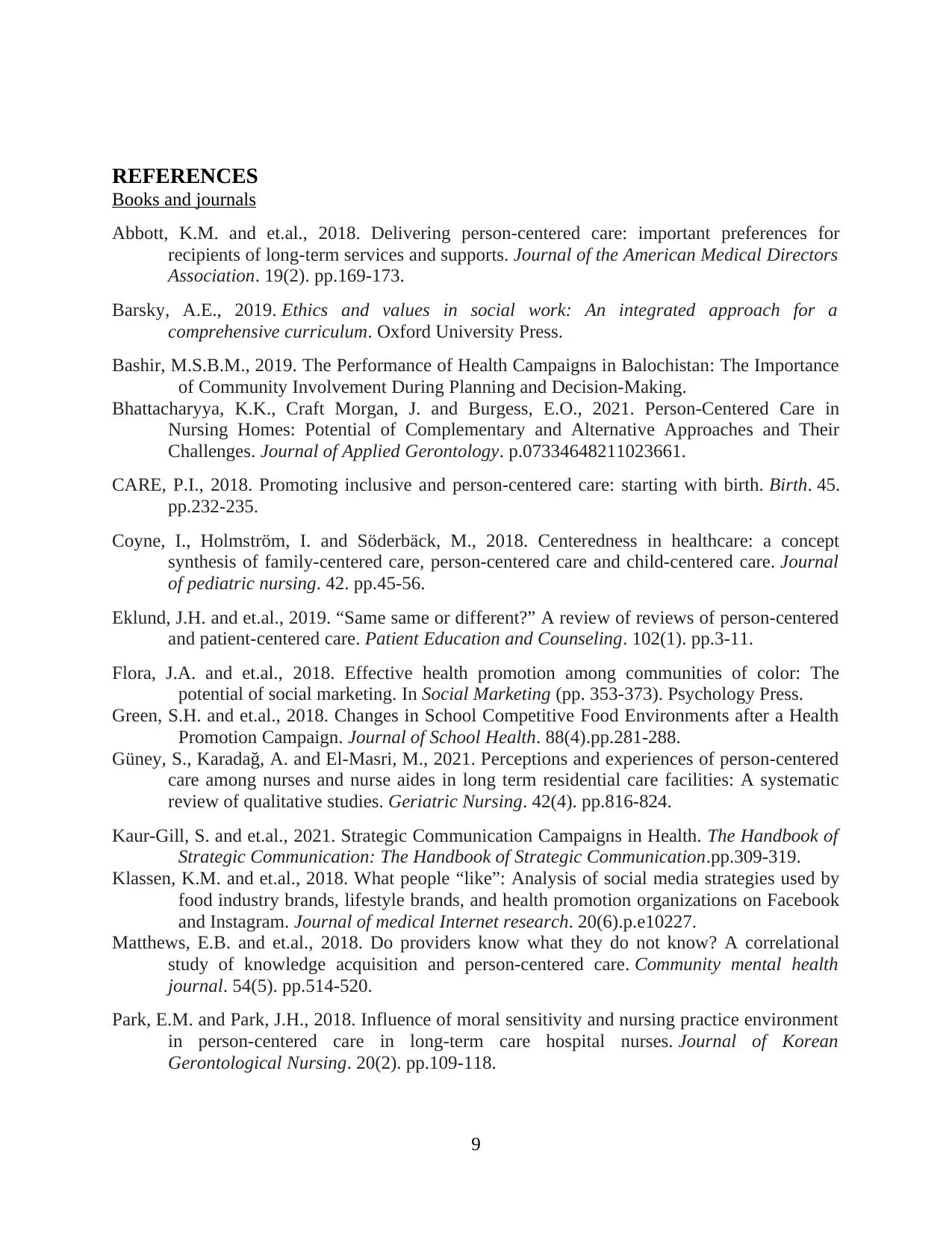
REFERENCES
Books and journals
Abbott, K.M. and et.al., 2018. Delivering person-centered care: important preferences for
recipients of long-term services and supports. Journal of the American Medical Directors
Association. 19(2). pp.169-173.
Barsky, A.E., 2019. Ethics and values in social work: An integrated approach for a
comprehensive curriculum. Oxford University Press.
Bashir, M.S.B.M., 2019. The Performance of Health Campaigns in Balochistan: The Importance
of Community Involvement During Planning and Decision-Making.
Bhattacharyya, K.K., Craft Morgan, J. and Burgess, E.O., 2021. Person-Centered Care in
Nursing Homes: Potential of Complementary and Alternative Approaches and Their
Challenges. Journal of Applied Gerontology. p.07334648211023661.
CARE, P.I., 2018. Promoting inclusive and person-centered care: starting with birth. Birth. 45.
pp.232-235.
Coyne, I., Holmström, I. and Söderbäck, M., 2018. Centeredness in healthcare: a concept
synthesis of family-centered care, person-centered care and child-centered care. Journal
of pediatric nursing. 42. pp.45-56.
Eklund, J.H. and et.al., 2019. “Same same or different?” A review of reviews of person-centered
and patient-centered care. Patient Education and Counseling. 102(1). pp.3-11.
Flora, J.A. and et.al., 2018. Effective health promotion among communities of color: The
potential of social marketing. In Social Marketing (pp. 353-373). Psychology Press.
Green, S.H. and et.al., 2018. Changes in School Competitive Food Environments after a Health
Promotion Campaign. Journal of School Health. 88(4).pp.281-288.
Güney, S., Karadağ, A. and El-Masri, M., 2021. Perceptions and experiences of person-centered
care among nurses and nurse aides in long term residential care facilities: A systematic
review of qualitative studies. Geriatric Nursing. 42(4). pp.816-824.
Kaur‐Gill, S. and et.al., 2021. Strategic Communication Campaigns in Health. The Handbook of
Strategic Communication: The Handbook of Strategic Communication.pp.309-319.
Klassen, K.M. and et.al., 2018. What people “like”: Analysis of social media strategies used by
food industry brands, lifestyle brands, and health promotion organizations on Facebook
and Instagram. Journal of medical Internet research. 20(6).p.e10227.
Matthews, E.B. and et.al., 2018. Do providers know what they do not know? A correlational
study of knowledge acquisition and person-centered care. Community mental health
journal. 54(5). pp.514-520.
Park, E.M. and Park, J.H., 2018. Influence of moral sensitivity and nursing practice environment
in person-centered care in long-term care hospital nurses. Journal of Korean
Gerontological Nursing. 20(2). pp.109-118.
9
Books and journals
Abbott, K.M. and et.al., 2018. Delivering person-centered care: important preferences for
recipients of long-term services and supports. Journal of the American Medical Directors
Association. 19(2). pp.169-173.
Barsky, A.E., 2019. Ethics and values in social work: An integrated approach for a
comprehensive curriculum. Oxford University Press.
Bashir, M.S.B.M., 2019. The Performance of Health Campaigns in Balochistan: The Importance
of Community Involvement During Planning and Decision-Making.
Bhattacharyya, K.K., Craft Morgan, J. and Burgess, E.O., 2021. Person-Centered Care in
Nursing Homes: Potential of Complementary and Alternative Approaches and Their
Challenges. Journal of Applied Gerontology. p.07334648211023661.
CARE, P.I., 2018. Promoting inclusive and person-centered care: starting with birth. Birth. 45.
pp.232-235.
Coyne, I., Holmström, I. and Söderbäck, M., 2018. Centeredness in healthcare: a concept
synthesis of family-centered care, person-centered care and child-centered care. Journal
of pediatric nursing. 42. pp.45-56.
Eklund, J.H. and et.al., 2019. “Same same or different?” A review of reviews of person-centered
and patient-centered care. Patient Education and Counseling. 102(1). pp.3-11.
Flora, J.A. and et.al., 2018. Effective health promotion among communities of color: The
potential of social marketing. In Social Marketing (pp. 353-373). Psychology Press.
Green, S.H. and et.al., 2018. Changes in School Competitive Food Environments after a Health
Promotion Campaign. Journal of School Health. 88(4).pp.281-288.
Güney, S., Karadağ, A. and El-Masri, M., 2021. Perceptions and experiences of person-centered
care among nurses and nurse aides in long term residential care facilities: A systematic
review of qualitative studies. Geriatric Nursing. 42(4). pp.816-824.
Kaur‐Gill, S. and et.al., 2021. Strategic Communication Campaigns in Health. The Handbook of
Strategic Communication: The Handbook of Strategic Communication.pp.309-319.
Klassen, K.M. and et.al., 2018. What people “like”: Analysis of social media strategies used by
food industry brands, lifestyle brands, and health promotion organizations on Facebook
and Instagram. Journal of medical Internet research. 20(6).p.e10227.
Matthews, E.B. and et.al., 2018. Do providers know what they do not know? A correlational
study of knowledge acquisition and person-centered care. Community mental health
journal. 54(5). pp.514-520.
Park, E.M. and Park, J.H., 2018. Influence of moral sensitivity and nursing practice environment
in person-centered care in long-term care hospital nurses. Journal of Korean
Gerontological Nursing. 20(2). pp.109-118.
9
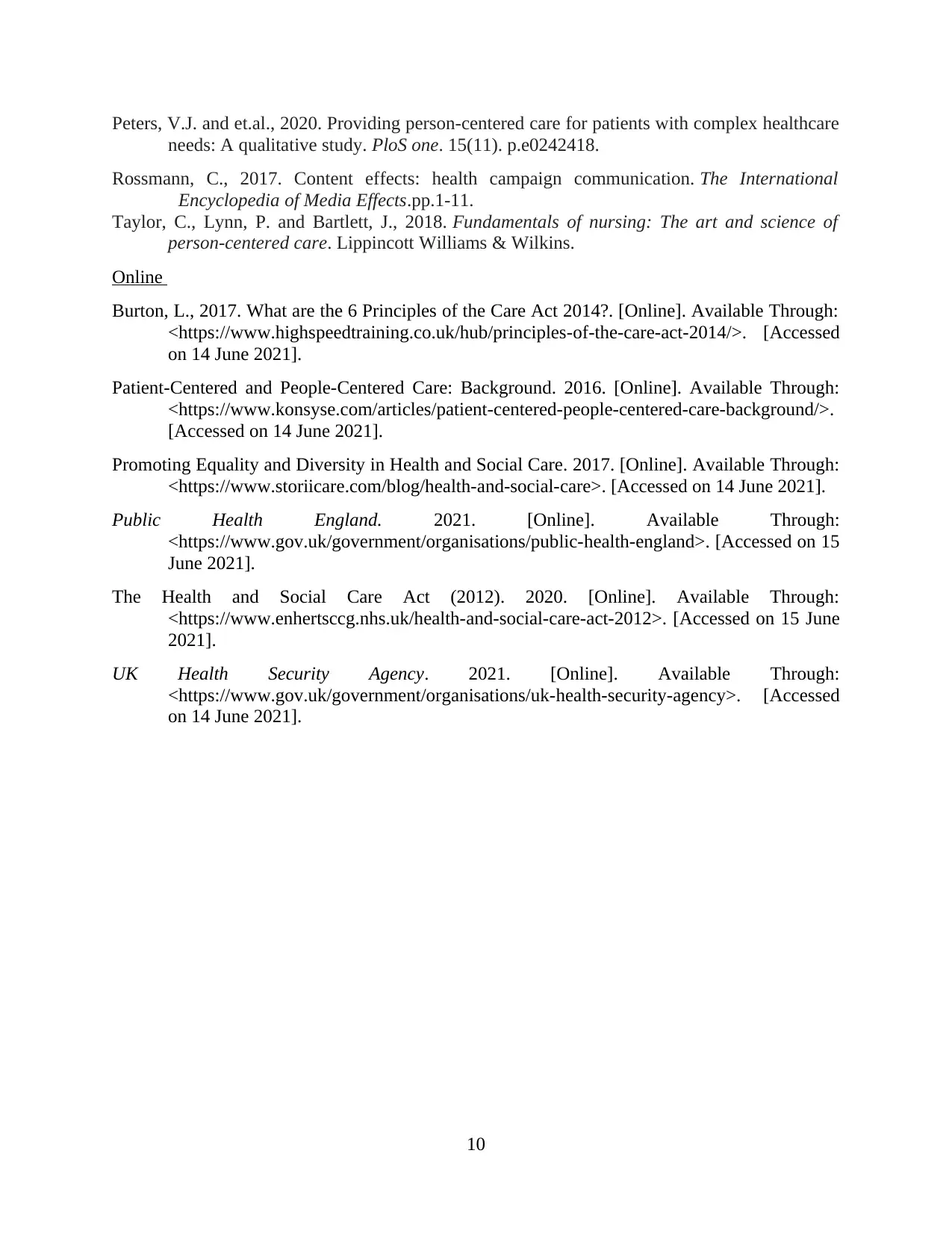
Peters, V.J. and et.al., 2020. Providing person-centered care for patients with complex healthcare
needs: A qualitative study. PloS one. 15(11). p.e0242418.
Rossmann, C., 2017. Content effects: health campaign communication. The International
Encyclopedia of Media Effects.pp.1-11.
Taylor, C., Lynn, P. and Bartlett, J., 2018. Fundamentals of nursing: The art and science of
person-centered care. Lippincott Williams & Wilkins.
Online
Burton, L., 2017. What are the 6 Principles of the Care Act 2014?. [Online]. Available Through:
<https://www.highspeedtraining.co.uk/hub/principles-of-the-care-act-2014/>. [Accessed
on 14 June 2021].
Patient-Centered and People-Centered Care: Background. 2016. [Online]. Available Through:
<https://www.konsyse.com/articles/patient-centered-people-centered-care-background/>.
[Accessed on 14 June 2021].
Promoting Equality and Diversity in Health and Social Care. 2017. [Online]. Available Through:
<https://www.storiicare.com/blog/health-and-social-care>. [Accessed on 14 June 2021].
Public Health England. 2021. [Online]. Available Through:
<https://www.gov.uk/government/organisations/public-health-england>. [Accessed on 15
June 2021].
The Health and Social Care Act (2012). 2020. [Online]. Available Through:
<https://www.enhertsccg.nhs.uk/health-and-social-care-act-2012>. [Accessed on 15 June
2021].
UK Health Security Agency. 2021. [Online]. Available Through:
<https://www.gov.uk/government/organisations/uk-health-security-agency>. [Accessed
on 14 June 2021].
10
needs: A qualitative study. PloS one. 15(11). p.e0242418.
Rossmann, C., 2017. Content effects: health campaign communication. The International
Encyclopedia of Media Effects.pp.1-11.
Taylor, C., Lynn, P. and Bartlett, J., 2018. Fundamentals of nursing: The art and science of
person-centered care. Lippincott Williams & Wilkins.
Online
Burton, L., 2017. What are the 6 Principles of the Care Act 2014?. [Online]. Available Through:
<https://www.highspeedtraining.co.uk/hub/principles-of-the-care-act-2014/>. [Accessed
on 14 June 2021].
Patient-Centered and People-Centered Care: Background. 2016. [Online]. Available Through:
<https://www.konsyse.com/articles/patient-centered-people-centered-care-background/>.
[Accessed on 14 June 2021].
Promoting Equality and Diversity in Health and Social Care. 2017. [Online]. Available Through:
<https://www.storiicare.com/blog/health-and-social-care>. [Accessed on 14 June 2021].
Public Health England. 2021. [Online]. Available Through:
<https://www.gov.uk/government/organisations/public-health-england>. [Accessed on 15
June 2021].
The Health and Social Care Act (2012). 2020. [Online]. Available Through:
<https://www.enhertsccg.nhs.uk/health-and-social-care-act-2012>. [Accessed on 15 June
2021].
UK Health Security Agency. 2021. [Online]. Available Through:
<https://www.gov.uk/government/organisations/uk-health-security-agency>. [Accessed
on 14 June 2021].
10
⊘ This is a preview!⊘
Do you want full access?
Subscribe today to unlock all pages.

Trusted by 1+ million students worldwide
1 out of 12
Related Documents
Your All-in-One AI-Powered Toolkit for Academic Success.
+13062052269
info@desklib.com
Available 24*7 on WhatsApp / Email
![[object Object]](/_next/static/media/star-bottom.7253800d.svg)
Unlock your academic potential
Copyright © 2020–2025 A2Z Services. All Rights Reserved. Developed and managed by ZUCOL.





